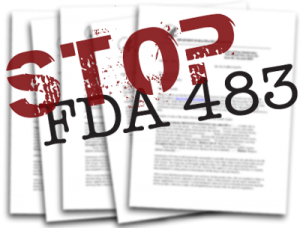FDA pushes worldwide, uniform device code
February 7th, 2012 // 1:30 pm @ jmpickett

New Webinar With Highly Detailed FDA 483/WL Data!
Millions of Americans are walking around with artificial joints, pacemakers, stents and other implants. But federal regulators know more about where a pallet of dog food went than a batch of hip replacements.
Unlike prescription drugs or, for that matter, food at the grocery store, medical devices have no uniform labeling system — like a bar code — that would allow a central, computerized database to keep track of them.
The result is that when a device is found to have problems, tracking down which hospitals have them, for instance, and in which patients they were implanted, can be extremely slow, labor-intensive and incomplete.
And problems occur. The Food and Drug Administration recalled more than 40 devices last year, including implantable defibrillator leads with the potentially lethal risk of pulling out of a patient’s heart and failing. They were distributed for more than nine years before the flaw was discovered and the recall was issued last November.
A solution approved by Congress nearly five years ago is stuck in the federal regulatory maze for reasons that are unclear.
It’s a pick-your-sad-joke kind of situation.
“We can recall tainted dog food faster than a pacemaker,†said Amanda Forster, a senior communications director at Premier, an alliance of 2,500 hospitals that is advocating for fast implementation of a universal labeling system. “It’s just shocking.â€
Congress voted overwhelmingly in 2007 for the FDA to create a uniform device identification system — standardized coding that would make tracking devices relatively simple with the same basic scanning technology used at the checkout counter.
It would bring other efficiencies — like inventory management for hospital systems — to bear as well. And the device industry is likely to benefit despite the significant upfront investment to put the systems in place.
The FDA has been coordinating with device regulators around the world in a push to develop a uniform code that would be a regulatory relief for an increasingly globalized industry.
“A unified system internationally is a big advantage for companies because we wouldn’t have to deal with 200 different sets of rules,†said Jeff Secunda, vice president for technology and regulatory affairs at AdvaMed, the industry’s major trade association.
The catch: After working for four years on the problem, the FDA sent its proposal last July to the Office of Management and Budget for review, and it’s been stuck there ever since. And the OMB has offered no explanation for the delay, to the growing frustration of industry, health care providers and consumer groups, who want to see the system in place soon.
That can’t happen before OMB releases the proposed rule, all of the stakeholders put in their two cents and the regulation becomes final.
In September, the original target date for the review, a group of hospital associations, specialty societies and others wrote a letter to then-OMB Director Jack Lew asking for quick action. They got no response.
Sen. Herb Kohl (D-Wis.) is drafting a letter to press OMB, too.
“[Unique device identifiers] provide an important post-market safety tool that would help track problems and allow recalled devices to be quickly located,†Kohl said in a statement to POLITICO, adding: “For every day that we wait on putting UDIs in place, a significant number of patients are placed at risk.â€
OMB declined to comment, but a representative said it’s not uncommon for review periods to be extended for far-reaching regulations.


